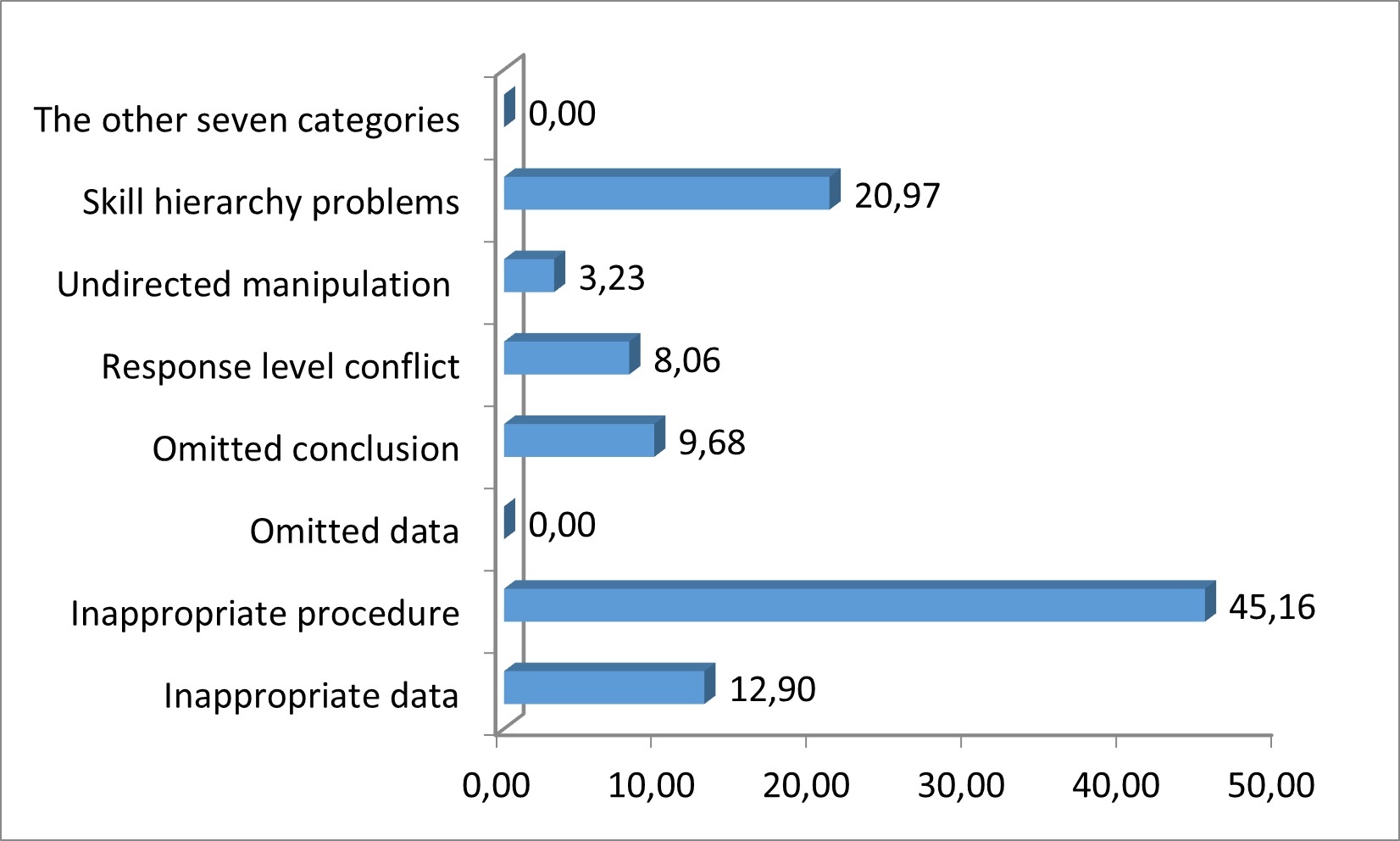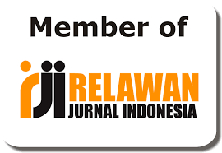Analysis of Student Errors Future Mathematics Teacher in Solving Complex Analysis Problems
DOI:
https://doi.org/10.33654/d8dxsm75Keywords:
complex analysis, inapropriate procedure, skill hierarchy problems, watson criteriaAbstract
This study aims to analyze the mistakes that are often made by future mathematics teachers when working on essay questions in complex analysis courses, using Watson criteria. This qualitative research was conducted in the odd semester of the 2023-2024 academic year, with the research subject being 5th-semester class C students at IAIN Syekh Nurjati Cirebon. From the data obtained, only 38.89% of students answered the questions correctly, while 61.61% of the errors made by students were categorized according to Watson's criteria. These criteria include inappropriate data (12.9%), inappropriate procedures (45.16%), omitted data (0%), omitted conclusions (9.68%), response level conflicts (8.68%), undirected manipulation (3.23%), skill hierarchy problems (20.97%), and other categories (0%). The most common error made by the majority of students was inappropriate procedures. This type of error often arises due to a lack of deep understanding of the material, confusion in applying certain concepts, or negligence in carefully reading instructions. Analysis of student errors based on Watson's criteria provides significant insight into the patterns of errors made by students.
Downloads
References
Afianti, F. D., Azizah, W., & Mahmudah, U. (2024). Error Analysis of Mathematics Tadris Students on The Level of Understanding in Solving Complex Analysis Problems. CONIE FTIK UIN K.H. Abdurrahman Wahid Pekalongan, 2431–2442. https://proceeding.uingusdur.ac.id/index.php/iconie/article/view/1917/996
Afniandari, L. N., Supardi, K. I., & Asikin, M. (2021). Understanding Mathematical Concepts in the Missouri Mathematics Project Learning Model in terms of Student’s Independent Attitude. Journal of Primary Education, 10(2), 163–178. https://journal.unnes.ac.id/sju/jpe/article/view/47947
Aswin, A., & Juandi, D. (2022). Using Watson Criteria for Analyzing Student Errors: Systematic Literature Review (SLR). Hipotenusa : Journal of Mathematical Society, 4(1), 13–23. https://doi.org/10.18326/hipotenusa.v4i1.7239
Beba, H., Sulistyaningsih, M., & Kaunang, D. F. (2022). Analisis Kesalahan Siswa dalam Menyelesaikan Soal Cerita Program Linear di SMA Negeri 1 Moronge. MARISEKOLA: Jurnal Matematika Riset Edukasi Dan Kolaborasi, 3(1), 29–36. https://doi.org/10.53682/marisekola.v3i1.1157
Buhaerah, B., Nasir, M., & Dangnga, M. S. (2022). Student’s Mistakes in Solving Problem Based on Watson’s Criteria and Learning Style. Jurnal Pendidikan Matematika (JUPITEK), 5(2), 95–104. https://doi.org/10.30598/jupitekvol5iss2pp95-104
de Vries, J. A., Dimosthenous, A., Schildkamp, K., & Visscher, A. J. (2022). The impact on student achievement of an assessment for learning teacher professional development program. Studies in Educational Evaluation, 74, 101184. https://doi.org/10.1016/j.stueduc.2022.101184
EL-Khateeb, Dr. M. M. (2016). Errors Analysis of Complex Numbers among Students of preparatory year at the King Saud University. Journal of Educational & Psychological Sciences, 17(3), 409–436. https://doi.org/10.12785/jeps/170315
Evriyanti, I., Yuniawatika, & Madyono, S. (2020). Errors Analysis Resolving Problems Story Based on Watson’s Error Category a Student in the 4 th Class of Elementary School . 487(Ecpe), 115–121. https://doi.org/10.2991/assehr.k.201112.022
Fritz, A., Ehlert, A., & Balzer, L. (2013). Development of mathematical concepts as basis for an elaborated mathematical understanding. South African Journal of Childhood Education, 3(1), 38–67.
Godino, J. D. (1996). Mathematical Concepts, Their Meanings, and Understanding. In P. y A. Gutierrez (Ed.), XX Conference of the International Group for the Psychology of Mathematics Education (Vol. 2, pp. 1–7). Universidad de Valencia. https://www.ugr.es/~jgodino/articulos_ingles/meaning_understanding.pdf
Haryanti, M. D., Herman, T., & Prabawanto, S. (2019). Analysis of students’ error in solving mathematical word problems in geometry. Journal of Physics: Conference Series, 1157, 042084. https://doi.org/10.1088/1742-6596/1157/4/042084
Hassan, K. El, & Madhum, G. (2007). Validating the Watson Glaser Critical Thinking Appraisal. Higher Education, 54(3), 361–383. https://doi.org/10.1007/s10734-006-9002-z
Hunaifi, & Darhim. (2020). Students error analysis in solving mathematical communication problems of square and triangle material for 7th grade based on watson criteria. International Conference on Elementary Education, 2(1), 914–924.
Kartikasari, A., & Widjajanti, D. B. (2017). The Effectiveness of Problem-Based Learning Approach Based on Multiple Intelligences in Terms of Student’s Achievement, Mathematical Connection Ability, and Self-Esteem. Journal of Physics: Conference Series, 812, 012097. https://doi.org/10.1088/1742-6596/812/1/012097
Kaur, T., & Prendergast, M. (2022). Students’ perceptions of mathematics writing and its impact on their enjoyment and self-confidence. Teaching Mathematics and Its Applications: An International Journal of the IMA, 41(1), 1–21. https://doi.org/10.1093/teamat/hrab008
Liew, C. Y., Leong, S. H., Julaihi, N. H., Lai, T. W., Ting, S. U., Chen, C. K., & Hamdan, A. (2022). Children’s Errors in Written Mathematics. Mathematics Teaching-Research Journal, 14(5), 141–158.
Lima, P. da S. N., Silva, L. das A., Felix, I. M., & Brandao, L. de O. (2019). Difficulties in Basic Concepts of Mathematics in Higher Education: A Systematic Review. 2019 IEEE Frontiers in Education Conference (FIE), 1–7. https://doi.org/10.1109/FIE43999.2019.9028658
Mafruhah, L., & Muchyidin, A. (2020). Analisis Kesalahan Siswa dalam Menyelesaikan Soal Cerita Matematika Berdasarkan Kriteria Watson. Pythagoras: Jurnal Pendidikan Matematika, 15(1), 24–35. https://doi.org/10.21831/pg.v15i1.26534
Maharani, A., Wahyuni, I., & Oktavianingsih, C. (2020). Watson’s Categories Analysis of Sequences and Series Question. Infinity Journal of Mathematics Education, 9(1), 31–40. https://doi.org/10.22460/infinity.v9i1.p31-40
Maskur, R., Sumarno, S., Rahmawati, Y., Pradana, K., Syazali, M., Septian, A., & Kinarya, E. (2020). The Effectiveness of Problem Based Learning and Aptitude Treatment Interaction in Improving Mathematical Creative Thinking Skills on Curriculum 2013. European Journal of Educational Research, 9(1), 375–383. https://doi.org/10.12973/eu-jer.9.1.375
Mazana, M. Y., Montero, C. S., & Casmir, R. O. (2019). Investigating Students’ Attitude towards Learning Mathematics. International Electronic Journal of Mathematics Education, 14(1), 207–231. https://doi.org/10.29333/iejme/3997
Meifiani, N. I. (2018). Profil Kesalahan Mahasiswa Pada Mata Kuliah Analisis Kompleks. Eksponen, 7(2), 80–86. https://doi.org/10.47637/eksponen.v7i2.152
Munna, A. S., & Kalam, M. A. (2021). Teaching and learning process to enhance teaching effectiveness: literature review. International Journal of Humanities and Innovation (IJHI), 4(1), 1–4. https://doi.org/10.33750/ijhi.v4i1.102
Nahdi, D. S., & Jatisunda, M. G. (2020). Conceptual Understanding and Procedural Knowledge: A Case Study on Learning Mathematics of Fractional Material in Elementary School. Journal of Physics: Conference Series, 1477(4), 1–6. https://doi.org/10.1088/1742-6596/1477/4/042037
Natalia, F., Rahman, A., Minggi, I., & Fausia, N. (2021). Description of Students Creative Thinking Abilities with Split Attention in Solving Math Problems. International Conference on Educational Studies in Mathematics (ICoESM 2021), 61(ICoESM), 505–510.
Nursalam, N., Angriani, A. D., Kamariah, K., Kusumayanti, A., & Yuliany, N. (2020). Students’ Errors in Resolving Set Item Test based on Watson’s Criteria. Proceedings of the International Conference on Mathematics and Islam (ICMIs 2018), 455–459. https://doi.org/10.5220/0008523604550459
Rohmah, M., & Sutiarso, S. (2018). Analysis problem solving in mathematical using theory Newman. Eurasia Journal of Mathematics, Science and Technology Education, 14(2), 671–681. https://doi.org/10.12973/ejmste/80630
Rulika, G. T., Prihatiningtyas, N. C., & Sumarli, S. (2024). Analisis Kesalahan Siswa dalam Menyelesaikan Soal Cerita Matematika Berdasarkan Teori Newman Materi Pecahan. Pedagogik Journal of Islamic Elementary School, 7, 1–18. https://doi.org/10.24256/pijies.v7i1.4923
Rushton, S. J. (2018). Teaching and Learning Mathematics through Error Analysis. Fields Mathematics Education Journal, 3(4), 1. https://doi.org/10.1186/s40928-018-0009-y
Sari, D. N., Usodo, B., & Pramudya, I. (2019). Analysis of Concept Understanding Student in Class X Inequalities Material. Journal of Physics: Conference Series, 1306(1), 012029. https://doi.org/10.1088/1742-6596/1306/1/012029
Smith, E. M., Zwolak, J. P., & Manogue, C. A. (2015). Student difficulties with complex numbers. 2015 Physics Education Research Conference Proceedings, 311–314. https://doi.org/10.1119/perc.2015.pr.073
Suciati, I., & Sartika, N. (2023). Students’ Errors Analysis in Solving Mathematics Problems Viewed from Various Perspectives. 12 Waiheru, 9(2), 149–158. https://doi.org/10.47655/12waiheru.v9i2.145
Surya, E., & Syahputra, E. (2017). Improving High-Level Thinking Skills by Development of Learning PBL Approach on the Learning Mathematics for Senior High School Students. International Education Studies, 10(8), 12–20. https://doi.org/10.5539/ies.v10n8p12
Utami, N. S. (2022). Analisis Kesalahan Mahasiswa Pada Bentuk Kutub Bilangan Kompleks Ditinjau dari Kemandirian Belajar. Jurnal Kiprah Pendidikan, 1(4), 237–246. https://doi.org/10.33578/kpd.v1i4.99
Wahyuni, S., Anggraini, V., & Melisa, M. (2023). Analisis Kesalahan Siswa Berdasarkan Kriteria Watson Materi Pola Bilangan di Kelas VIII.3 SMPN 3 Batang Anai. Jurnal Pendidikan Tambusai, 7(3), 21375–21383. https://doi.org/10.31004/jptam.v7i3.9896
Warner, S., & Kaur, A. (2017). The Perceptions of Teachers and Students on a 21st Century Mathematics Instructional Model. International Electronic Journal of Mathematics Education, 12(2), 193–215. https://doi.org/10.29333/iejme/609
Yolanda, F., & Sthephani, A. (2021). Analisis Kesalahan Mahasiswa Pendidikan Matematika UIR pada Penyelesaian Analisis Kompleks. SJME (Supremum Journal of Mathematics Education), 5(1), 32–42. https://doi.org/10.35706/sjme.v5i1.4393

Downloads
Published
Issue
Section
License

This work is licensed under a Creative Commons Attribution-ShareAlike 4.0 International License.



















